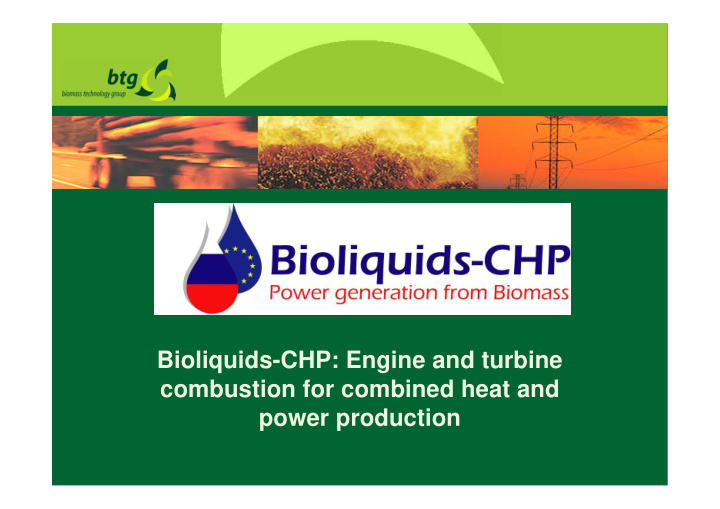



Bioliquids-CHP: Engine and turbine combustion for combined heat and power production
General project data FP7 Call: FP7-ENERGY-2008-RUSSIA Activity code: ENERGY.2008.2.2.1: Enhancing strategic international cooperation with Russia in the field of power generation from biomass FP Grant: 227303 Duration: January 2009 – December 2011 (36 months) Total budget: € 4,309,696 of which € 1,602,319 funded by the EC Website URL: www.bioliquids-chp.eu (available Spring 2009) Coordinator: John Vos, Tel +31-53-486 1191, vos@btgworld.com BTG Biomass Technology Group BV P.O. Box 835, 7500 AV Enschede, Netherlands Josink Esweg 34, 7545 PN Enschede, Netherlands Bioliquids CHP: slide 2
Project objectives Main objective: To adapt engines/turbines to enable operation on a variety of bioliquids, including pyrolysis liquids; Specific objectives: To upgrade bioliquids or to prepare blends/emulsions of bioliquids to enable their use in engines/turbines; To find a technical and economic optimum between fuel upgrading and engine/turbine modification; To develop methods/techniques to control exhaust emissions (NO x , CO, particulates); To evaluate the complete chain (sustainability, economics, technology, environment, market opportunities) for application in EU & Russia Bioliquids CHP: slide 3
Project background Combined heat and power (CHP) is a very efficient way of using energy sources 2010 target: CHP to contribute 18% of European energy supply In Russia, many CHP units are used, in particular in remote areas. Implementation of smaller scale, direct biomass CHP systems has been limited for various reasons e.g. high investment and running costs, poor reliability, low acceptance by end-user. At the root of these reasons: presence of contaminants in biomass, non- uniform appearance of biomass, low energy density, complicated operation, difficulty to operate on varying load Using biomass derived liquids (in short: bioliquids) instead of direct biomass will overcome the main barriers hindering a wider use of biomass in smaller scale CHP systems. Bioliquids CHP: slide 4
General overview Bioliquids - Pyrolysis oil from pine - Pyrolysis oil from straw - Vegetable oil Engines - Biodiesel - Diesel engine Gas cleaning Upgrading - Catalytic engine - NO X - Filtration - CO - Dewatering - Hydrocarbons - Chemical treatment (Micro-) Turbines Emulsions/Mixtures Clean flue gas Heat Electricity Cooling Bioliquids CHP: slide 5
Project partnership BTG Biomass Technology Group BV (NL) EnConTech BV (NL) University of Florence, CREAR (Italy) Boreskov Institute of Catalysis, Siberian Branch of Russian Academy of Sciences (Russia) Federal State Unitary Enterprise 'Central Scientific Research Automobile and Automotive Engines Institute' - FSUE 'NAMI' (Russia) Aston University (United Kingdom) The Likhachev Plant (AMO ZIL) (Russia) Bioliquids CHP: slide 6
Project team Kick-Off Meeting, Enschede (NL), February 2009 From left: Valeriy Kirillov (BIC), Bert van de Beld (BTG), Erich Nägele (EC), Emma Wylde (Aston), Jan Florijn (BTG), Tony Bridgwater (Aston), John Vos (BTG), Alexandre Thebaud (BTG), David Chiaramonti (Florence), Andrea Maria Rizzo (Florence), Alexander Kronberg, Martin Sprenkeler, Maxim Glouchenkov (all EnConTech), Nikolay Khripach (NAMI) Bioliquids CHP: slide 7
Work packages WP 0 (BTG) Project management, coordination & dissemination WP 3 (UFL) WP 1 + 2 (BTG) Micro-Turbines WP 5 (BIC) Bioliquids Emission production, reduction analysis & WP 4 (NAMI) upgrading Engines WP 6 (Aston) Techno-economic assessments & market potential Bioliquids CHP: slide 8
Expected outputs The main outputs of the project include: Reports on the characterisation of feedstock samples in relation to combustion properties and emissions. Report on pyrolysis oil upgrading tests Report on bio-liquids mixing / emulsification tests Study of technical feasibility of micro gas turbine and report on major adaptation description. Reports on engine modifications and testing of new developed components and engine. Report on the construction and final testing of the integral exhaust gas cleaning system. Information for developers to address planning and other regulations associated with installation of Bio-oil CHP applications. Bioliquids CHP: slide 9
Expected impacts The strategic impacts of the project include: Increase in electricity production from biomass by reducing bioliquids production prices and by improving bioliquids quality. Reduction of costs of electricity production from biomass. Optimisation of the engine-bioliquid fuel combination Adaptation of existing technologies (bioliquid production, diesel engines and CHP-units) with a view to optimise the engine-fuel combination Improvement of the environment, the quality of life, health and safety. Bioliquids CHP: slide 10
Co-operation with Russia Bioliquids CHP is a Joint Research Project with Russia The three Russian partners receive funding though the Federal Agency for Science and Innovations (FASI) of the Russian Federation. Some information on the Russian sister project: – Lot 2008-0-2.7-13-01 - Development of technology and equipment for energy generation from biomass – Focus on (1) Catalysts development, (2) Fuel modification and 930 Conversion of bioliquids to synthesis gas – FASI funding: 72 Million Rubles (at mid-2008 exchange rate equivalent to 1.944.000 Euro) – Project started in June 2008, end date formally September 2011 but to be reconciled with FP7 project (end date December 2011) – Partners involved are FSUE NAMI (lead), BIC and AMO ZIL. Bioliquids CHP: slide 11
Acknowledgement This project is financially supported by the Seventh Framework Programme of the European Commission (Grant agreement no. 212180) and the Federal Agency for Science and Innovations of the Russian Federation (FASI contract 02.527.11.0003) This document reflects only the project consortium’s views. The European Community is not liable for any use that may be made of the information contained herein Bioliquids CHP: slide 12
Recommend
More recommend